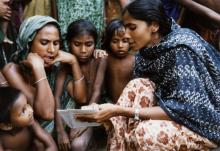
Community-based family planning (CBFP) brings family planning (FP) information and services to women and men in the communities where they live, rather than requiring them to travel to health facilities. Ideally, CBFP should be considered as part of the broader health system to ensure that the program provides a sustainable solution for meeting the FP-related health care needs of the population.
This course orients the learner to the essential elements for designing and implementing successful, sustainable CBFP programs. It describes three popular approaches to CBFP—provision by community health workers (CHWs), mobile outreach services, and drug shops—and provides an opportunity for users to practice what they learned using a case study.
Objective
By the end of the course, the learner will be able to do the following:
- Describe the basic features and programmatic objectives of community-based family planning (CBFP)
- Describe the essential elements required for a sustainable CBFP program
- Describe the features of three CBFP approaches: provision by community health workers (CHWs), mobile outreach services, and drug shops
- Consider the circumstances/conditions presented in a case study and decide which CBFP approach(es) would be most appropriate
Credits
The authors of the revised Community-Based Family Planning course would like to acknowledge the original course authors, Victoria Graham (USAID), Catherine Toth (Consultant), and Mia Foreman (ICF Macro), who developed the first edition of the course in November 2009. We would also like to thank Kirsten Krueger, Morrisa Malkin, John Stanback, and Dawn Chin-Quee at FHI 360; Tom Ellum at Marie Stopes International; and Victoria Graham and Elaine Menotti at USAID, who served as reviewers and subject matter experts for this update.
Time
- 2 hours
Published/Updated
- Thursday, January 26, 2017
Course Authors:
Leigh Wynne, FHI 360
Lucy Harber, FHI 360
Course Managers:
- Lisa Mwaikambo, CCP
Related Courses
- Family Planning 101
- Family Planning Programming - Elements of Success
- Logistics for Health Commodities
- Social Franchising for Health
- Commercial Private Health Sector Basics
- Healthy Businesses
- Health Workforce Productivity: An Approach for Measurement, Analysis, and Improvement
- A Total Market Approach to Family Planning Services
Related Toolkits
- Community-Based Access to Injectable Contraceptives(link is external)(link will open new window)
- Community-Based Family Planning(link is external)(link will open new window)
- Elements of Family Planning Success(link is external)(link will open new window)
- Family Planning Logistics(link is external)(link will open new window)
- Health Workforce Productivity Analysis and Improvement(link is external)(link will open new window)
- Health and Development Programming Integration(link is external)(link will open new window)
- Family Planning Advocacy(link is external)(link will open new window)
- Measuring Success Toolkit: Using Data for Health Program Planning, Monitoring and Evaluation(link is external)(link will open new window)
- Leadership and Management(link is external)(link will open new window)
